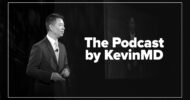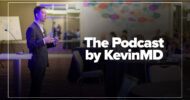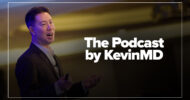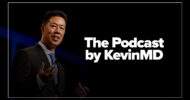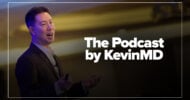Subscribe to The Podcast by KevinMD. Watch on YouTube. Catch up on old episodes!
Emergency physicians Resa E. Lewiss and Courtney M. Smalley discuss their article, “Why point-of-care ultrasound belongs in emergency department triage.” Amid the crisis of overcrowded waiting rooms and long wait times, they argue for the immediate integration of a powerful, underutilized tool: point-of-care ultrasound (POCUS). Resa and Courtney use compelling clinical examples, like identifying a collapsed lung or a ruptured ectopic pregnancy in under two minutes, to show how POCUS can dramatically improve risk stratification and save lives before a patient even leaves the triage area. They counter potential objections by explaining that emergency physicians are already highly trained in POCUS, the technology fits existing workflows, and it is a billable procedure that can generate revenue. The conversation serves as a direct call to action for hospital leaders to redesign triage spaces and protocols, making POCUS a standard of care to ensure the sickest patients are identified and treated without delay.
Careers by KevinMD is your gateway to health care success. We connect you with real-time, exclusive resources like job boards, news updates, and salary insights, all tailored for health care professionals. With expertise in uniting top talent and leading employers across the nation’s largest health care hiring network, we’re your partner in shaping health care’s future. Fulfill your health care journey at KevinMD.com/careers.
VISIT SPONSOR → https://kevinmd.com/careers
Discovering disability insurance? Pattern understands your concerns. Over 20,000 doctors trust us for straightforward, affordable coverage. We handle everything from quotes to paperwork. Say goodbye to insurance stress – visit Pattern today at KevinMD.com/pattern.
VISIT SPONSOR → https://kevinmd.com/pattern
SUBSCRIBE TO THE PODCAST → https://www.kevinmd.com/podcast
RECOMMENDED BY KEVINMD → https://www.kevinmd.com/recommended
Transcript
Kevin Pho: Hi, and welcome to the show. Subscribe at KevinMD.com/podcast. Today we welcome Resa E. Lewiss and Courtney M. Smalley, both emergency physicians. Their KevinMD article is “Why point of care ultrasound belongs in emergency department triage.” Resa and Courtney, welcome to the show.
Resa E. Lewiss: For having us.
Courtney M. Smalley: Thanks for having us.
Kevin Pho: All right, so Resa, I am going to ask you to talk about this article. For those who did not get a chance to read it, what is it about?
Resa E. Lewiss: Thanks for that question. So people are very familiar that point-of-care ultrasound is a part of patient care. In fact, it is required for emergency medicine training. What they may not yet be aware of is this concept of a physician and provider in triage, which has become a mainstay, specifically in crowded emergency departments, crowded waiting rooms, and generally in large academic hospitals.
What is not yet there as a mainstay is point-of-care ultrasound, and Dr. Smalley—Courtney—and I strongly believe that ultrasound needs to be there just like it is in every other part of the emergency department.
Kevin Pho: So Resa, currently, what are some of the conditions or scenarios that you would use point-of-care ultrasound in today?
Resa E. Lewiss: There are so many. For listeners who are not familiar, point-of-care ultrasound is the same as clinical ultrasound, which is the same as emergency ultrasound. This is a focused patient care, patient safety, diagnostic, and procedural use of ultrasound at the bedside, at the point of care. So typically, there are yes-no questions. In the article, we actually present a case of a young, otherwise healthy patient that is short of breath, and by using the ultrasound in triage, a pneumothorax is diagnosed.
These are very focused, yes-no questions that help us with triaging on acuity because, specifically in triage in these emergency departments, patients get an ESI score. We firmly believe that ultrasound can provide a data point and should be used to provide a data point to help with patient safety.
Kevin Pho: And tell us what an ESI score is, Dr. Smalley.
Courtney M. Smalley: So this is a score that every patient gets when they sign in and come through the waiting room. They get triaged into acuity. And this ESI score is a one-through-five score looking at the sickest patient. An ESI one would be a patient that is basically peri-arrest and needs to go right back, maybe even comes in through the back door. Most of our patients that come through the waiting room are going to be an ESI two or an ESI three, meaning they need either urgent or semi-emergent care. But it is not as simple as an ESI four or five, which could be something as simple as a sprained ankle or a medication refill. This score is basically a culmination of the chief complaint, the look of the patient, and it includes vital signs. So again, we really think that an extra point to help with that ESI determination should be ultrasound.
Kevin Pho: So Courtney, you’re talking, or you and Resa are talking about ultrasound, of course, in the triage stage, right? So is that not common? Is that not happening today?
Courtney M. Smalley: Yeah, that’s a great question. So as we have moved ultrasound across emergency medicine over the years, we have found that ultrasound can be used in almost any environment. Over the years, we have seen ultrasound originally just starting in the trauma bay in a trauma setting where we were looking at sick trauma patients, and that was in conjunction with our trauma surgery colleagues. And that was in the eighties and the nineties and early two-thousands. The emergency medicine specialty found that there were many exams that we could utilize at the bedside, and that really brought emergency medicine ultrasound outside of the trauma bays and into almost every patient care room in the emergency department.
Crowding and boarding has become something, especially in the last five years, that is now a much higher topic of conversation amongst emergency medicine physicians. As we see that our patients are sicker, there are more patients, and our waiting rooms are full. And so what we have noticed is that this transition of bringing the ultrasound to a new environment has not necessarily jumped into that environment yet. And so when I have been clinically working, I have been bringing that ultrasound out to triage and saying, you know, why can’t we use this here? We can ask a quick yes or no question. We are so skilled as emergency physicians in the setting of bedside ultrasound that many of us can do a quick yes or no exam in under a minute or two minutes.
And so it really does not change the time. We are always stressed about time. In the emergency medicine world, time is very important. We need to move, we need to get to the next patient, but this is something that we are trained to do from the beginning. We start our residency training so we can bring that ultrasound out into triage, and so we are advocating that now is the time to kind of look at this new environment and say, hey, we can bring this handheld ultrasound, we can put an ultrasound in our pocket. I can go from triage room to triage room to triage room with an ultrasound and make diagnoses and help our patients get better care.
Resa E. Lewiss: And to be clear, the cart-based units as well, like EKGs, are done in triage as well, so it’s not even a space-occupying technology. And the workflows are built; you’re using the same electronic health record, you’re typing to the same computer. So actually completing the examination is the same workflow that physicians would be using in the main parts of emergency departments.
Kevin Pho: Resa, you talk about a second case about an ectopic pregnancy, so just give us an example of how that point-of-care ultrasound really modified risk stratification.
Resa E. Lewiss: And this is sort of a very, very timely case given the current changes that are happening across state by state in our country with abortion laws. So patients come to the emergency department; sometimes pregnancy status is known, sometimes it is unknown. But if someone has lower abdominal pain, with ultrasound, you could put that probe right above the bladder and see whether or not there is free fluid. The case we talk about is a patient that comes in with lower abdominal pain, which is actually a very common complaint in the emergency department. Her vital signs were stable. She, quote, “looked well,” but the physician put a probe right above the bladder and saw free fluid in places it should not be.
The urine pregnancy test was positive, and within an hour the specialist, the OB-GYN, was called, and she ultimately went to the operating room with a ruptured ectopic pregnancy. Otherwise, someone who looks good with stable vital signs would potentially sit in the waiting room for hours.
Kevin Pho: According to you, how long does it take for an emergency physician to be proficient in point-of-care ultrasound?
Courtney M. Smalley: That’s a great question. And so, I love the concept of competency and training of our emergency medicine residents. So Emergency Medicine residency has built-in training for point-of-care ultrasound. So from the day our residents hit the door on day one, they are automatically given an ultrasound and told, this is a key part of your training and we are going to make sure that by the time you finish your three or four-year residency training that you have done many ultrasounds.
The guidelines used to say that the residents had to do about 150 ultrasounds in many modalities before they could graduate, but I would say the current state of our emergency medicine residencies is such that our residents are doing upwards of three or four hundred. In fact, we just had a graduation and one resident hit 500 ultrasounds in three years, so we are very competent at the bedside. By the time our emergency medicine residents graduate and they go into practice, they are very skilled at making these quick diagnoses, asking the critical questions, and looking for the unstable patients.
Resa E. Lewiss: And Kevin, just to close the loop on that question, which I agree is an excellent question, is how do you measure competency? The thing about ultrasound, it is not just performing it, but it is also getting images that are interpreted, the ability to interpret the images, and then integrate it into patient care. So there is actually a three-step process when training emergency medicine residents, and again, it is not just emergency medicine. Many specialties are using ultrasound, and everybody has the same question: How do you determine competencies? Those three things: acquiring images, interpreting the image, and then integrating it into the assessment and plan.
And so there is a lot of literature in the emergency medicine space talking about numbers-based, like there is a certain number of examinations that need to be acquired for a certain exam, a test. And then there is also that demonstration either by direct observation in the emergency department or in the simulation space to get those other pieces of the interpretation and the integration.
Kevin Pho: So it has been a while since I have stepped foot in the emergency department. Courtney, what is the current penetration of point-of-care ultrasound? How common is it, say, in a typical community setting, a community emergency department?
Courtney M. Smalley: So I would say it is very common, and many of our community emergency physicians are using ultrasound every day at the bedside. The studies that I find our community physicians are using it for is cardiac and lung in that unstable patient that hits the door, who is in respiratory distress to make the diagnosis of COPD, CHF, or pneumothorax, so many of these critical diagnoses. But we are finding that a lot of our APP colleagues that are working with us side-by-side in the emergency department are using it for things like abscess I&D and cellulitis. So it is very common. You know, many of our community physicians are using it a couple of times every shift. And it really does augment their patient care.
Resa E. Lewiss: Anybody who practices with patients that might be considered difficult IV access, perhaps because of diabetes, perhaps because of peripheral vascular disease, ultrasound is used every shift, many times a shift, to assist with ultrasound-guided peripheral IV placement.
In addition, our pediatric emergency medicine physicians choose and want to be able to use ultrasound because of the lack of radiation that the modality has as part of the way it works, but also you can bring it bedside so you do not have to transport patients. And also it saves the radiation, for example, of a chest X-ray. All the patients that might come in with RSV or pneumonia, you can use an ultrasound probe bedside, real-time, with no radiation and have answers.
Kevin Pho: So Resa, obviously this article was written because point-of-care ultrasound is not used as much as you would like in the triage setting. What are some of the friction points? Why is this not happening?
Resa E. Lewiss: Yeah, it is a great question. And you know, it circles back to why now, why this article? Because we think, why are not people just bringing it? I think sometimes, you know, it does not strike people because it is literally often a different physical space. Courtney actually pointed into this concept of time urgency. Like there is no time. I do think people think it takes, quote, “a lot of time,” and we sort of put forth, we posit, that it does not take a lot of time. You are not doing five different applications. You are doing a focused application based on the chief complaint.
And you know, we started the article by saying no one wants a patient to deteriorate or even die in the emergency department. Physicians do not want it, patients do not want it, patient caregivers do not want it. And so if you have the easy, quick ability to answer that question and get some more data to be like, OK, this patient is OK to sit, you know, for a few more hours. You know, we by no means are making the argument that every single patient is emergent and every single patient needs 20 ultrasound examinations. It is really to help get that focused, yes-no question answered so that there is a reassurance like, OK, this person can wait until they are called and there is a bed that is open in the back. It’s again, it’s a patient-focused, patient safety measure.
And back to your question, the pushback is, I think, the concept of time. The concept of space. I think it just has not struck people because they are not used to seeing ultrasound up front. They are used to seeing it in the trauma resuscitation room. They are used to seeing it, you know, wherever people need IVs placed in beds. So I think it is a new space. And I think also the provider-in-triage model is not everywhere, but it is spreading. And as people are designing, you know, human-centered design is all about bringing the end-users to the table. I think in creating these spaces, if you were to bring physicians and residents to the design process of these triage spaces, they would say, we need an ultrasound machine there.
Kevin Pho: And Resa, you mentioned some of the chief complaints that would warrant a triage point-of-care ultrasound, obviously chest pain, shortness of breath, abdominal pain. What are some other chief complaints that would trigger a point-of-care ultrasound within a triage setting?
Resa E. Lewiss: Courtney had a great case that she describes that literally we could all imagine this patient would have sat for hours and really deteriorated. It was a patient that had a high BMI, was obese, and had leg pain, and the leg pain was very high up. So the team was essentially saying, “Oh, it’s probably just a UTI.” There was something that went off, a spidey sense for Courtney, and she put the probe over the area that was painful and it was necrotizing fasciitis.
Kevin Pho: Courtney, give us a sense if you were to redesign the emergency department from scratch, give us your ideal scenario where point-of-care ultrasound would be used in triage. Just give us a story or a hypothetical example of how this workflow would be in action.
Courtney M. Smalley: Yeah, I think you have heard a couple of examples of where we talk about maybe some critical diagnoses that we are making in triage, and I think those are very relevant to the listener, and we all, again, want those patients out of our waiting rooms and into treatment rooms where they can get the care that they need. But some of the ideas that we are starting to explore as we look into future models of ultrasound in triage is also making those diagnoses. So I will give you an example. An example would be a patient coming into triage who has got blurry vision or a curtain in their vision. And I cannot tell you how many patients in the last year, just as I see the chief complaint as a vision issue, I walk in with my probe, I put the ultrasound on the eye, and I diagnose them with a retinal detachment.
So what I do is I walk out and now I just call the eye specialist, and the patient can leave my waiting room and go directly over to the eye center and get the care that they need, as opposed to that consultative service having to come over to the ER to see this patient or this patient waiting in the waiting room for many, many hours to get back to a treatment area. I can make that diagnosis from the front and start working on their plan of care.
And there are a lot of different examples where we can use, as an example, such as this, where we can start thinking about how do we save time for our consultative services? How do we help them triage their time so that we can get those patients to them quicker? And maybe they do not need long lengths of stays in the emergency department if we can make some of these diagnoses from the front. So these are the things that we are exploring over the next six months as we try to build out, you know, these critical diagnoses, right? You hear pneumothorax, necrotizing fasciitis, but also just general diagnoses that may have some good outcomes for patients and allow them to have a better experience through our emergency department front doors.
Resa E. Lewiss: More on the business piece: this is integrated into the electronic health record, the EHR, and it is part of the ultrasound workflow such that when the provider in triage does the examination, those images are saved and they are uploaded, so then they are viewable across the hospital system on PACS. So this is a communication tool, this is a patient care tool, and a note is written.
So back to the business case. Ultrasound is a codeable and billable procedure. And when I say procedure, we are not necessarily doing an ultrasound procedure; just in its diagnosis, it is under a CPT code that is considered, quote, “a procedure.” But this is an examination that can be billed for, and this is a way of making sure it is not just, quote, “a waste of time” to get extra data, although I do not consider it a waste of time. It is really a patient-focused, patient safety measure.
Kevin Pho: So Resa, what are some immediate next steps if we want to propagate the use of point-of-care ultrasound in a triage setting?
Resa E. Lewiss: Well, I think my first is to thank you for bringing us on this podcast because we are getting the message out. I think once it is on people’s radar, people literally will have that aha moment, like, oh my gosh, why don’t I bring an ultrasound machine when I do my triage shifts? Many of our emergency medicine colleagues are doing triage shifts. It literally is becoming the mainstay of care because of the crowding, and I think it is only going to continue. So publishing on it, writing about it, speaking about it, but I think also there is an element of science.
We need numbers, we need data. Courtney and her colleagues have put together a bit of a retrospective chart review, looking at cases, and I think the way things progress in terms of getting established, you have the case report, then you have the case series, then you have the retrospective chart review, then you have the prospective convenience sample. You know, I have worked enough in emergency departments, in systems, they are like, that’s great. That’s great. You know, those of you who are very excited about ultrasound, I think we will have to make the business case to show that we are not adding too much time to that evaluation and triage process. Also, that there is a business case. Finally, I will say I have worked in places where there are not enough machines, and I think that we need to make sure that the equipment, the devices are available, and with the cost and portability of handhelds, it is going to be more difficult to make the argument that we do not have the machinery available.
Kevin Pho: We’re talking to Resa E. Lewiss and Courtney M. Smalley, both are emergency physicians. Today’s KevinMD article is “Why point of care ultrasound belongs in emergency department triage.” I am going to end with asking you your take-home messages that you want to leave with the KevinMD audience. Courtney, why don’t you go first?
Courtney M. Smalley: Great. Thank you first of all for having us. I am so excited about bringing this concept into the triage space, and I am hoping that emergency physicians and other physicians across multiple specialties can see that this can be done in any of these quick settings with the right environment and the right support. We hope that your listeners will consider this, take it away, walk into their environment tomorrow and look at their space and say, yes, I can do this in this space. And so, we are excited to potentially move the needle forward.
Kevin Pho: And Resa, we’ll end with you. Your take-home messages?
Resa E. Lewiss: I would say it is never, ever, ever, ever, ever wrong to focus on patients and patient safety. That can be your guiding principle as a health care worker, as a physician. Trust your gut and always make it about safe, better, patient-centered care.
Kevin Pho: Resa and Courtney, thank you so much for sharing your perspective and insight. Thanks again for coming on the show.
Resa E. Lewiss: Thanks so much for the opportunity.
Courtney M. Smalley: Thank you, Kevin.








